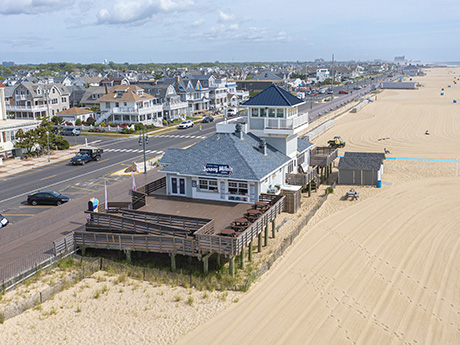How QSRs are powering the rise of hyper-local retail real estate.
The quick service restaurant (QSR) industry is reshaping retail real estate by capitalizing on the “15-minute city” trend — a movement where people can access essentials within a short walk, bike ride, or delivery window from home. This shift, fueled by evolving consumer behavior, urban densification, and the rise of digital ordering, is pushing QSRs to prioritize hyper-local presence over traditional highway or regional hubs. The result is a transformation in both real estate development and the metrics that define success in the foodservice sector.
Embedding into Daily Life
Hyper-localization is about placing restaurants within the flow of everyday life — close to where people live, work, and socialize. Rather than clustering around big-box retail or commuter corridors, many brands now target neighborhood locations near apartment clusters, schools, and small mixed-use developments.
7 Brew Coffee, a drive-thru-only brand, exemplifies this model. Its small footprint and fast service make it ideal for small lots and secondary intersection spots once overlooked by national tenants. These locations are now thriving due to residential growth and proximity to commuter paths. With minimal barriers to entry and an emphasis on quick service, 7 Brew is establishing a strong local presence in zones where Starbucks or Dunkin’ may not operate.
Taco Bell has also reimagined its real estate strategy with the launch of the “Taco Bell Go Mobile” concept. Designed for app orders and delivery, these compact stores need far less space than traditional units and are perfectly suited for urban infill. In cities like Austin and Charlotte, these stores are strategically placed in high-density areas where demand for takeout is strong. Go Mobile units are integrated with digital ordering, boosting convenience and efficiency — hallmarks of the 15-minute city. These locations attract both walk-in traffic and third-party delivery platforms thanks to their proximity and design for rapid kitchen throughput.
Digital-First, Local-Focused Models
Wingstop has embraced a digital-forward, neighborhood-oriented approach by moving away from dine-in service. Its real estate strategy now revolves around ghost kitchens, endcap inline spaces, and compact urban storefronts. In cities like Phoenix and Dallas, Wingstop has small-format stores in local strip centers that support both pickup and delivery. With more than 65 percent of its sales coming through digital channels, Wingstop benefits from locations near residential rooftops instead of traditional retail anchors — delivering faster service, lower rents, and better delivery performance.
Chipotle, a pioneer in fast-casual dining, has evolved to prioritize hyper-local, digital-first development. Its “Chipotlanes” — drive-thru lanes for digital order pickup — are appearing not only along suburban arterials but also within residential and mixed-use areas. In Nashville and Denver, Chipotle is opening these units in digitally engaged neighborhoods that lack healthy fast-food options. Walkable store formats in apartment complexes are also part of its strategy, further cementing Chipotle’s role as a local fixture. These moves reduce delivery distances and integrate the brand into daily community rhythms.
Jersey Mike’s, another fast-growing QSR, also exemplifies hyper-local thinking. The brand focuses on endcap and inline units in neighborhood shopping centers near grocery stores, gyms, and schools. With a flexible footprint and franchise-friendly model, it can rapidly expand into infill spaces. In places like Raleigh and Salt Lake City, Jersey Mike’s stores are located within walking distance of homes, offices, and schools — serving customers exactly when and where they need fresh, fast meals. Its growing digital ordering presence enhances both delivery and in-store experiences.
Rethinking Real Estate Success
The move toward hyper-localization is also redefining how QSRs evaluate site success. Traditional metrics — such as visibility from major roads and traffic counts — are being replaced by more nuanced indicators like delivery radius efficiency, population density within walkable zones, and app order penetration. A site previously dismissed for low drive-by exposure might now be considered ideal if it’s within biking distance of thousands of residents.
This evolution offers both opportunities and complexities for developers and landlords. Demand is growing for compact, flexible retail spaces, especially in mixed-use or residential projects with good parking or delivery access. Tenants like Wingstop and 7 Brew are even willing to pay premiums for prime neighborhood locations. As a result, brokers must merge demographic insights with delivery logistics and digital infrastructure to meet QSR demands.
QSRs as Neighborhood Anchors
More than just dining destinations, QSRs are becoming vital infrastructure within communities. Brands like Taco Bell, Chipotle, Wingstop, 7 Brew, and Jersey Mike’s are not only adapting to hyper-local preferences but also catalyzing a broader shift in how retail real estate is developed. Their localized strategies are delivering shorter wait times, stronger brand loyalty, and a community-focused approach to growth. As cities continue to grow and consumers value speed and proximity, QSRs will play a central role in shaping the next generation of urban retail — embedding themselves not just as places to eat, but as everyday essentials in the evolving landscape of localized living.
— Casey Smallwood, senior vice president and managing principal in the Louisville, Kentucky, office of SRS Real Estate Partners
This article was originally published in the August 2025 issue of Shopping Center Business magazine.


